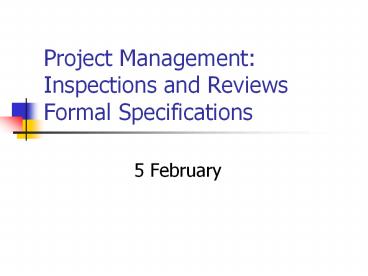Project%20Management:%20Inspections%20and%20Reviews%20Formal%20Specifications - PowerPoint PPT Presentation
Title:
Project%20Management:%20Inspections%20and%20Reviews%20Formal%20Specifications
Description:
Review implies completed work, often reviewed by someone at a ... VDM (Praxis: UK Civil aviation display system CDIS), Z (Oxford and IBM: CICS), Larch (MIT) ... – PowerPoint PPT presentation
Number of Views:73
Avg rating:3.0/5.0
Title: Project%20Management:%20Inspections%20and%20Reviews%20Formal%20Specifications
1
Project ManagementInspections and
ReviewsFormal Specifications
- 5 February
2
Deliverables
- Design Document
- Only highest levels
- Details will be filled in
- Living document
3
Reviews and Inspections
4
Reviews and Inspections
- Why?
- Developer cant correct unseen errors
- More eyes to catch problems
- Earlier is cheaper
- Integration fix typically 3-10 times the cost at
design - Difference in terms
- Review implies completed work, often reviewed by
someone at a different level - Inspection implies peer review of work in progress
5
Software Inspections
- Disciplined engineering practice for detecting
and correcting defects - Introduced at IBM by Fagan in the 1970s
- More formal than walkthroughs or peer reviews
- Roles, statistics
- Used for specs, code, test plans,
6
Uses
- Early detection of errors
- Major escapes cost 2-10 times as much minor 2-4
- Identification of excellence indicators
- Completeness (requirements to code)
- Correctness (specification to code)
- Style (consistency)
- Exit criteria for life cycle phases
7
Additional Benefits
- Programmer finds errors and types of errors that
he is apt to make immediately - Awareness means focus on those types of errors
and therefore improved skills - Designers get feedback on quality of their
designs - Using statistical anomalies to recode
8
Why do inspections work?
- More eyes
- Focused activity
- Structure
- Timely
- Measurable criteria for passing and rework
- Required follow-up
9
Why Arent Inspections Used?
- Rigorous and formal (requires training)
- Time consuming
- 4-5 people over multiple 2 hour sessions
- 250-500 lines of code per hour
- 5-10 errors detected per session
- Boring, low tech
- Egos
10
References
- Fagan, Design and code inspections to reduce
errors in program development, IBM Systems
Journal (reprinted 99) - Porter, Siy and Votta, A Review of Software
Inspections, 1995
11
Will you review or inspect?What?How?
12
Formal Specifications
13
Formal Methods and Specifications
- Mathematically-based techniques for describing
system properties - Used to show completeness, consistency,
unambiguity - Able to be used without executing the program
(inference systems)
14
Inference Systems
- Proving something about the specification not
already stated - Formal proofs
- Mechanizable
- Examples theorem provers and proof checkers
15
Users of Specifications
- Requirements analysis
- rigor
- System design
- Decomposition, interfaces
- Verification
- Specific sections
- Documentation
- System analysis and evaluation
- Reference point, uncovering bugs
16
Properties of Specifications
- Unambiguous
- Maps to a single specificand set
- Consistency
- Maps to a non-empty specificand set
- Completeness
- Not required!
- Balance between underspecification and
overspecification
17
Examples of Specification Languages
- Abstract data types
- Algebras, theories, and programs
- VDM (Praxis UK Civil aviation display system
CDIS), Z (Oxford and IBM CICS), Larch (MIT) - Concurrent and distributed systems
- State or event sequences, transitions
- Hoares CSP, Transition axioms, Lamports
Temporal Logic - Programming languages!
18
References
- J.M. Wing, A Specifier's Introduction to Formal
Methods. IEEE Computer, 23(9)8-24, September
1990. - Clarke et al, Formal methods state of the art
and future directions, ACM Computing Surveys,
28(4) 626--643, 1996.































